At a Glance
Summary
The results of the CHILD DEVELOPMENT test were interesting and I learnt some valuable information about the traits my son is likely to develop as he gets older. However, despite being aimed at parents that want insights into their child's development, many aspects of the process and report didn’t cater to this audience or purpose.
In particular, I found it frustrating that the advice mainly focused on recommendations for adults. Whilst these might be useful in the future, it’ll be a long time before my son is able to use them and I had been hoping for advice on how to nurture his natural talents as a child. That said, there was some useful information included and I look forward to seeing how my son's genetically-predicted traits develop as he grows up.
Full Review
ORIG3N is a Boston-based company that promotes and develops personalized approaches to healthcare, via its DNA tests and research into stem cell treatments. It was founded by Robin Smith and Kate Blanchard in 2014 and sells a range of health and trait-related genetic tests. As the mother of a one-year-old child (Harry) myself, I was keen to give their 'CHILD DEVELOPMENT' test a go!
Product Expectations
The CHILD DEVELOPMENT test had its own page on the ORIG3N website. This explained that the test would look at 24 genes, to report on four areas of development: ‘Enlightenment’, ‘Fitness’, ‘Health’ and ‘Nutrition’. I was able to see the individual results that would be included in each of these sections, as well as the name of the gene that would be analyzed for each.
This page also included pictures of the kit and its components, which provided a good preview of what I’d receive and revealed that I’d be able to access the results via an app.
At the bottom of the page, a set of five ‘How It Works’ steps were accompanied by symbols that reassured me the process would be straightforward and painless (a particularly important issue for me because of my son’s age). This linked to a full How It Works page which provided more detail, as well as information about privacy and how to download the app.
Ordering Experience
The ordering process was split into three stages, ‘Customer information’, ‘Shipping method’ and ‘Payment method’. In the first of these, I entered my name, email, and shipping address. Next, I was given three delivery options. I was pleased to see that standard shipping was free, but that I could speed it up by paying for 2-day or overnight FedEx delivery.
In terms of payment, I was able to use Visa, Mastercard, Amex, Discover, ‘and more…’ to purchase the test. I entered my details and clicked to save them for a faster checkout next time. Before submitting my order though, I looked through the Terms of Service and Privacy Policy. These weren’t too complex or confusing and I particularly appreciated ORIG3N's acknowledgement that “users are the sole owners of their genetic information”. This meant that they wouldn’t use it for anything other than to provide the service I’d purchased, unless explicit consent was given.
Once I’d completed my order, an email confirmed my purchase and I received the kit soon afterwards. It looked just like the one I’d seen in the product description and I’d have been happy to have given or received it as a gift. Using the swab to take the sample was quick and simple (even for a one year old!) and I was pleased to see that return postage and packaging had been included.
The Results
The test was being done using my son’s DNA, so I put his name on the registration card that I sent back with his sample. As I was the one receiving the results though, I registered the kit online in my name and with my email address.
Soon after I’d sent off the samples, I received an email from a member of ORIG3N’s customer support team to ask why the names differed. Although I explained that the sample was my 17-month old son’s, they asked me to provide an alternative email address so that they could register the sample to an account in his name. This seemed a strange system considering my child was obviously not old enough to have his own email address. The product description had also clearly been aimed at selling the test to parents, not the children themselves.
However, I provided an alternative and received another email (addressed to my son) about six weeks later. This informed me that the results were ready, so I logged into the account that had been set up with this second email address to view them.
I was first shown a dashboard that included all of the test options offered by ORIG3N. All except CHILD DEVELOPMENT were greyed out, so it stood out and was easy to find. I clicked on it and could see that the results were sorted into the four sections I’d seen in the product description (shown below).

The four results sections.
There was also a PDF version of the report available to download. I looked at it after going through the results online, and found the same information, but in a simpler format. An example of one of the results is shown below.
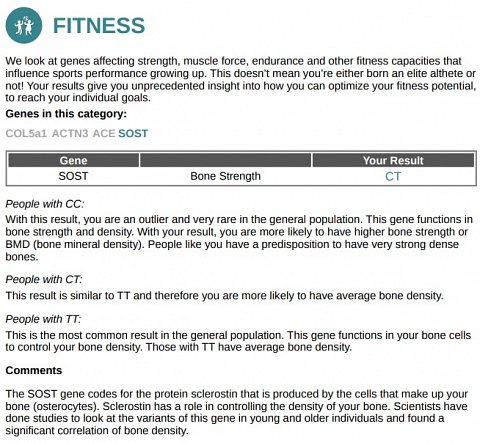
One of the results from the PDF document.
I preferred the online version, but it was useful to have an offline, printable copy of the results.
Results Section: Enlightenment
Going through the online results, I looked first at the Enlightenment section. This included 10 results that mainly covered learning traits, but also things like ‘Perfect Pitch’ and ‘Noise-Induced Memory Loss’. Each trait had been classed as ‘Normal’, ‘Adapt’ or ‘Gifted’. Some of the results are shown below.
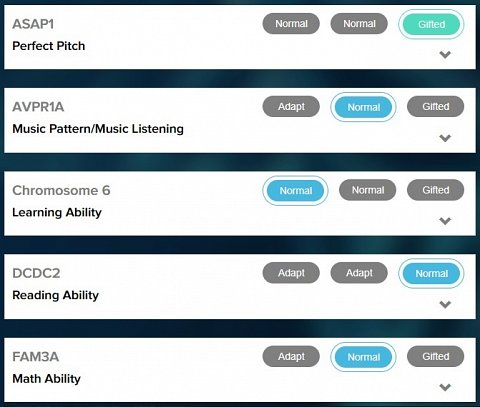
Some of the Enlightenment results.
I was happy to see that, out of the 10 results, only two were ‘Adapt’ and the Perfect Pitch result was ‘Gifted’. I was interested to find out more about this, so clicked to expand it. This opened a section with three tabs, one for each possible result, with Harry’s shown as default (shown below).
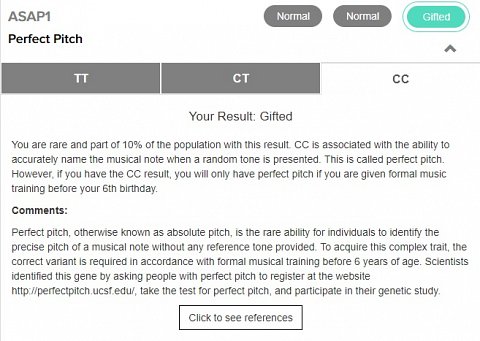
The expanded Perfect Pitch result.
Each tab was labelled with two letters, which although not explained specifically, were referenced to as 'the result' in the explanation. I guessed these were the letters in the DNA code that had been used to conclude that Harry was ‘Gifted’ in this trait.
Reading through the explanation, I found out that he was part of only 10% of the population with this result and had the potential to accurately name the exact musical note when played a random tone. However, this would only be possible if he were given formal musical training before the age of six. I felt that this was a valuable insight, as I could now take action to help him make the most of talents that we might not have been aware of otherwise.
The results were written in the second person, referring to ‘you’, which I thought was odd. This was again because the product description on the website had clearly been aimed at parents, selling the benefits of knowing about a child’s talents. The terms and conditions had also clearly stated that those under 18 could not submit a sample without a parent or guardian’s consent, so the service didn't seem to be designed for a child to order themselves.
This wasn’t a major issue though and I moved on to the Fitness section to look at ways my son might succeed in sport, according to his DNA.
Results Section: Fitness
There were four Fitness results, ‘Cardiac Output’, ‘Muscle Force’, ‘Joint Strength and Flexibility’ and ‘Bone Strength’. One was ‘Gifted’ (Muscle Force), one was ‘Adapt’ (Joint Strength and Flexibility), and the other two were ‘Normal’. This time, I decided to focus on the ‘Adapt’ result, as I wondered if there were things I could implement early on in my son’s life to prevent this becoming a problem for him as he got older.
I clicked to expand the result and found quite a lengthy explanation. This revealed that Harry (again referring directly to him) was part of 30% of the population with this result. It referred to studies that had shown that it was associated with a higher chance of injury, due to ‘greater than normal joint hyperextension’ during intense exercise. I wasn’t quite sure what this meant, but was pleased to see that advice on how to avoid it had been included.
This advice was practical and wide ranging, suggesting actions from nutritional supplements to employing a personal trainer. However, although these recommendations might be useful when he’s grown up, I had been hoping for some activities that I could try with Harry straight away. In addition, when talking about the studies, the explanation referred to women specifically, so I wasn’t sure if the result was relevant to males.
The second half of the explanation was sub-headed ‘Comments’ and went over some of the science behind the result. I learnt that the gene (COL5a1) helped the body make one of the major proteins found in bones, ligaments, tendons, and cartilage. I thought this was quite a clear explanation, and it was followed by five references to supporting scientific studies, meaning I could research further if I wanted.
Results Section: Health
The next section was called Health and included five results. These reported on ‘Sleep Duration’, ‘Adolescent Behavior’, ‘Norwalk Virus Resistance’, ‘Sleep Disruption’ and ‘Prion Disease Resistance’. Aside from Norwalk Virus and Prion Disease Resistance, these results seemed to be more child-focused, particularly the ones that covered sleep! However, I found that when reading through them, they still tended to focus on issues more relevant to adults, such as the lack of sleep impacting on decision making.
That said, the Adolescent Behavior result did provide information I could use in terms of Harry’s development. I was relieved to see that his result was ‘Normal’, meaning he was less likely to develop unhealthy habits during adolescence and would also be likely to have better memory and attention than others.
In terms of the disease resistance results, I wasn't sure what either of them were. However, the explanation for the Norwalk virus result explained that it was the same as Norovirus, which I did know about. Harry's result was 'Adapt', meaning he was susceptible to it. This worried me until I read the 'Gifted result explanation, which revealed that only 15% of the population are resistant.
For the second of the conditions, I found out he was likely to be resistant to prion diseases that are caused by eating contaminated meat. I was especially relived about this result when I looked up prion diseases online, as they were described as “usually rapidly progressive and always fatal”.
These conditions seemed quite randomly chosen – as far as I could tell they weren’t associated with child development specifically – and I was surprised that this otherwise light-hearted test provided these potentially distressing results with little warning or support.
Results Section: Nutrition
The final section, Nutrition, contained five results, which I felt were the most age-appropriate ones in the whole report. Unfortunately, Harry had three ‘Adapt’ results in this section, ‘Feeling Full’, ‘Folate Levels’ and ‘Sweet Tooth’. As someone with a sweet tooth myself, the last of these didn’t come as much of a surprise, but I was interested to see the details of the genetics behind this. It was quite a rare result (only about 20% of the population shared it) and was associated with an intermediate rather than significantly higher consumption of sugar.
Unfortunately, the accompanying advice was a little vague. Although the explanation included a long list of common sources of sugar, there were no suggestions of healthier alternatives to help satisfy sugar cravings. I initially thought it was helpful that the recommended daily amount of sugar was included, but soon realised it was for a fully-grown adult so it wasn’t really relevant to my son.
The other results were interesting though, and learning that Harry was likely to enjoy the taste of cilantro was something I wouldn’t otherwise have known about until he was older. I also found it valuable to learn that he wasn’t genetically predisposed to lactose intolerance, but was likely to be susceptible to low folate levels. Learning about these meant I could take action to include more folate-rich foods in his diet but wouldn’t have to worry about giving him dairy. I was also pleased to find that, unlike the sweet tooth result, there were lots of food suggestions provided for the Folate Levels result.
Results Section: Genes
There was one more section of the report which allowed me to look through the results, via the genes analyzed rather than the trait or condition they were associated with. A few of these results are shown below.
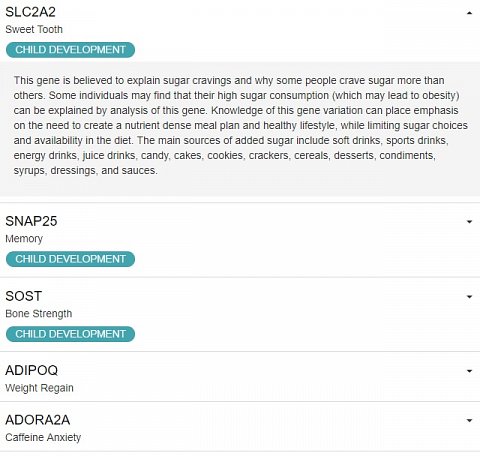
Part of the Genes section.
I appreciated having an alternative way to see the results and the fact that the'd been alphabetized made it easy to find specific genes. The list included all of the genes that were analyzed by ORIG3N, across all tests, so I was glad that the relevant ones had been labelled with ‘CHILD DEVELOPMENT’.
Summary
The results of the CHILD DEVELOPMENT test were interesting and I learnt some valuable information about the traits my son is likely to develop as he gets older. However, despite being aimed at parents that want insights into their child's development, many aspects of the process and report didn’t cater to this audience or purpose.
In particular, I found it frustrating that the advice mainly focused on recommendations for adults. Whilst these might be useful in the future, it’ll be a long time before my son is able to use them and I had been hoping for advice on how to nurture his natural talents as a child. That said, there was some useful information included and I look forward to seeing how my son's genetically-predicted traits develop as he grows up.
At a Glance
Summary
The SUPERHERO test was a lot of fun. I learnt some unexpected things about myself and was pleasantly surprised to also receive practical advice for improving my fitness routine. I did feel a bit let down by the fact that one of the three sections advertised on the site had not been included in the results, with no explanation as to why this was the case.
However, I found the information that was included genuinely interesting and a lot less gimmicky than I’d expected. Overall, it provided a great, light-hearted introduction to DNA testing and, for the price, there wasn’t much not to like!
Full Review
The ‘SUPERHERO’ DNA test is one of six sold by Boston-based company, ORIG3N. The company was founded in 2014 by Robin Smith and Kate Blanchard, with a focus on helping to promote and develop personalized approaches to healthcare. In addition to DNA testing, it carries out research into stem cell treatments for a range of health conditions. As well as SUPERHERO, ORIG3N offers tests that report on nutrition, fitness, skin characteristics, behavior and child development.
I decided to take the SUPERHERO test, to find out how many super powers I might have hiding in my DNA!
Product Expectations
The ORIG3N homepage was bright and welcoming. There were separate pages dedicated to each test, so I headed straight to the SUPERHERO one. Here, I learnt that it would analyze six genes to report on three areas of ‘superhero-ism’: Strength, Intelligence, and Speed. Within each of these areas, I’d receive results about two specific traits and was impressed to see that details of the genes (or, in one case a chromosome) that would be analyzed to report on each were included.
Pictures of the kit, its contents and previews of sample results accompanied this description, and, at the bottom of the page, there was a ‘How it works’ section, which provided a straightforward overview of the process. This linked to a full page that included further, more detailed information about how the testing would work.
In addition to the process, this page included details about the lab and the privacy of my genetic data. I was also interested to read that, should I want to take more ORIG3N tests later on, I wouldn’t need to submit another sample, as they could use the data from the one I provided this time. Whilst this would make it extra convenient, I wasn’t sure how I felt about ORIG3N retaining my sample after the testing had been carried out.
Ordering Experience
Ordering the test was straightforward. I added it to my cart, and went straight to the checkout page. I entered my email address, shipping address and had the option to add my phone number. I was happy to see that postage was free, unless I wanted it more quickly via FedEx (2 days or overnight options were available).
Looking at the privacy policy, I was initially impressed to read that, unless I explicitly consented to sharing it, my genetic data wouldn’t be used for anything other than the service I purchased. However, reading on, I was concerned to find out that if I did consent to sharing my data, ORIG3N had the right to use it however and whenever they wanted to. I wouldn’t be informed about how my data was being used or have the right to withdraw my consent once I’d given it.
This was worrying, but I appreciated that I was not automatically opted in and was pleased to see that they had included exactly how this consent would be asked for (via a popup once I’d received my results). Knowing what to watch out for was helpful and reassured me that I wouldn’t opt in accidentally.
I paid with my credit card (which was the only option available) and received an email confirming my order.
The kit arrived about a week later and it looked just like the one I’d seen on the website – I thought it would make a great gift. The swab was easy to use and sampling took less than 5 minutes. I registered my kit and was pleased to see that return postage had been included. Soon after I’d dispatched my samples, I was sent an email notifying me that they had arrived at the lab.
The Results
I received another email notifying me that my results were ready around a week later, which was much quicker than had been estimated on the website. This email informed me that I could access my results via the account I’d set up when registering the kit.
When I’d logged in, I found a dashboard of all the tests ORIG3N offered, with the ones I hadn’t taken greyed out. I clicked on SUPERHERO to open a menu that showed two sections, ‘Intelligence’ and ‘Speed’ (shown below).

The menu of sections in the report.
I was confused about why the ‘Strength’ section wasn’t included, and couldn’t find any explanation about where it was.
Results Section: PDF Report
This menu page also included a link that allowed me to download a PDF version of the report. I was interested to see whether this would include my Strength results, so downloaded a copy.
The homepage included a ‘Superhero’ picture and a list of the three sections of results I’d seen on the website (shown below), which made me think that Strength had been included in this version of the report.
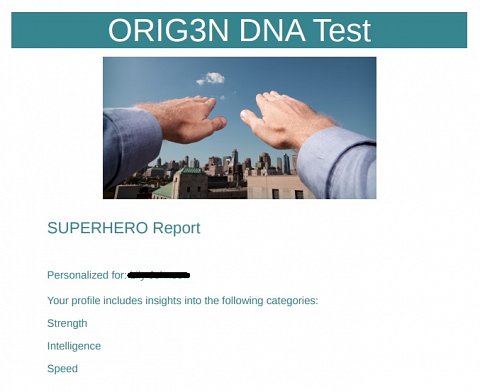
The PDF version of my report.
However, as I scrolled down the page, it became clear that, although it had been included in the list at the top, there wasn’t actually a results section for it in this version of the report either.
The results were presented in a clear, but quite basic and text heavy way in this document, so I decided to look through my results in the online version. A section of one of my results is shown below.
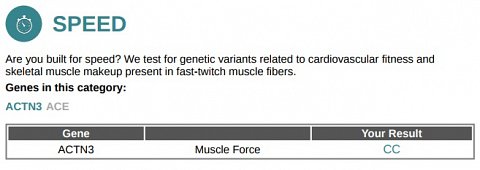
A section of my Speed results in the PDF report.
Results Section: Intelligence
Going back to the online version, I looked first at the Intelligence results. This section contained two results, ‘Learning Ability’ and ‘Language Ability’. It was immediately obvious that my result for the first was ‘Gifted’ and for the second was ‘Normal’. This was made clear by three icons that showed the possible outcomes, with one highlighted with my result (shown below).
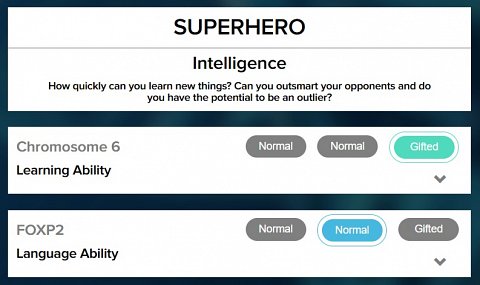
My Intelligence results.
I was intrigued to learn that I am supposedly ‘Gifted’ in terms of my Learning Ability, and clicked to expand the result, so that I could read more about what this actually meant.
To my surprise, I read that my result was rare, and only found in 15% of the population. It had been discovered, in a study of 125,000 people, to be associated with “several years of successful education and higher scores in achievement tests”. I was interested to find out more about this study, so was pleased that a list of two references had been included beneath the result, meaning I could read through the research myself. Although the number varied, but there were references provided for all the other results too.
The second result was ‘Normal’, but this actually meant it was likely to take me longer to learn language skills. I wasn’t sure if this meant in comparison to those that were ‘Gifted’ or to those with an average ability.
For both results, there were three tabs, providing information about my result in one and the other possible outcomes in the other two. Each of these was titled with two letters, but I wasn’t sure what these stood for and couldn’t find anywhere that explained. I guessed it had something to do with the letters in the DNA code that had been used to determine the result.
Results Section: Speed
The other section of the report focused on two ‘Speed’ superhero qualities, ‘Cardiac Output’ and ‘Muscle Force’. As someone who had thought I was naturally unsuited to any kind of exercise, I was shocked to discover that I was ‘Gifted’ in both of these areas!
For Cardiac Output I was again part of only 15% of the population with this result. I read that although it meant I would likely excel at short, intense periods of exercise (for example when sprinting) I would probably have less natural endurance.
I was surprised to learn that for Muscle Force, I was part of a much larger proportion of the population (45%) that shared this result. Again, this indicated that I’d be good at activities requiring quick bursts of energy. Apparently, the gene that had been analyzed to provide this result (ACTN3) was the most studied fitness-related gene. I read that if I was also ‘Gifted’ in Vo2Max and endurance I’d likely be good at sports like rowing. This was interesting to know but also a bit frustrating, as the report didn’t report on either of these traits and didn’t provide any further information about how to find this out.
I appreciated the fact that, for both results, suggestions of specific exercises had been included. This was a bonus, as I had only expected the test to provide a bit of fun information, but now had a way in which to easily apply the results and an idea of which activities that I was likely to naturally be better at.
Summary
The SUPERHERO test was a lot of fun. I learnt some unexpected things about myself and was pleasantly surprised to receive practical advice for improving my fitness routine. I did feel a bit let down by the fact that one of the three sections advertised on the site had not been included in the results, with no explanation as to why this was the case.
However, I found the information that was included genuinely interesting and it was a lot less gimmicky than I’d expected. Overall, it provided a great, light-hearted introduction to DNA testing and, for the price, there wasn’t much not to like!
At a Glance
Summary
Overall, ORIG3N's BLISS test provided an interesting insight into my personality. While the results weren't extensive, and some were oddly specific to responses to illegal drugs, I still found that in general the test was an enlightening experience.
I was made conscious of vices I should be more aware of, and of my own genetic strengths, which gave me a new perspective on aspects of my character and behavior. Due to the wide range of traits reported on and the fact that there were some unusual results included, I’d recommend this even to those that have already taken a behavioral DNA test, as well as those that haven’t.
Full Review
ORIG3N is an American biotech start-up that was founded in 2014, Boston Massachusetts, with a mission to use DNA tests as a way of empowering people to take charge of their health. Headed by Robin Smith and Kate Blanchard, the company specializes in the research of pioneering treatments for genetic conditions, including those that affect the liver, heart, and nervous system. This expertise has allowed them to develop consumer DNA tests which can report on diet and fitness, behavioral and physical traits and even ‘superhero’ qualities.
Product Expectations
The ORIG3N website was very sleek and easy to navigate, and I saw that they offered a range of tests. I opted for BLISS, a behavioral test which would reveal how my biology might be affecting my brain. It would assess 24 genes in four different categories: ‘Addiction’, ‘Feelings’, ‘Behavior’ and ‘Tolerance’. All the genetic traits that were going to be screened for were listed in the product description, along with the specific genes that would be examined in each category.
A ‘How it works’ section at the bottom of the product page explained the process of testing, using symbols to illustrate each step. This also linked to a full How it works page, which included more details about the process, sample instructions and pictures of the kit, a link for registering it and information about the privacy of my data. I was excited, if a little nervous, to find out more about the biological aspects of my personality.
Ordering Experience
On ORIG3N's website I found a rigorous privacy policy that stated I was the sole owner of my genetic information, and that my data would be kept private unless I consented to its use for research. However, I was a little perturbed to see that if I did consent to my data being used, then that consent was perpetual and irrevocable, and that I had no say over what happened to it. I made a mental note not to tick any boxes without reading the terms and conditions properly first.
I ordered my BLISS test online with a credit card, as this was the only option for payment, and received the kit in the post shortly afterwards. The box was really nicely put together, and all the instructions were very clear for the cheek swab and registration process, with my registration code on a card on the box. I was pleased to see that return postage was included, making it easy to send my sample off to be processed.
The Results
I was pleasantly surprised to receive my results only a week after I had sent them, which was much sooner than the website had predicted. I was sent an email notifying me that my results were ready, and logged into my account to find a dashboard. When I clicked on BLISS I was taken to a page that showed four icons, each representing one of the different results sections: ‘Addiction’, ‘Feelings’, ‘Behavior’ and ‘Tolerance’ (shown below).

List of the four BLISS categories.
Above these options was a box that contained the name of the report (BLISS), my sample I.D. and a link that allowed me to download the results as a PDF. I decided to look at the results online first, but was pleased to have an offline version available.
Results Section: Addiction
The first results section was Addiction, which included seven results. Next to each trait was a row of three possible results, and it was clear that mine was the one which was highlighted. The three possible results were ‘Adapt’, ‘Normal’ and ‘Gifted’. I couldn’t find anything in the report that explained exactly what these meant. Since all my ‘Adapt’ results were highlighted in red, I assumed these were the bad ones, the '‘Gifted’' results highlighted green were good, and the ‘Normal’ results in blue were neutral.
I saw that my result for 'CNR1 Marijuana dependence' was ‘Gifted’ (shown below), and clicked it to find the result expanded into a more detailed explanation.

My result for Marijuana Dependence.
There were three descriptions, shown in three tabs, labelled ‘GG’, ‘GT’ and ‘TT’. I wasn’t sure what these stood for, but it was clear that my result description was shown in the one labelled 'TT'. The explanation of the result told me that the version of the gene I had was common to 45% of the population, and it meant I was at the lowest genetic risk of substance dependency and abuse, which I was happy to hear. A second section of the explanation was preceded with the subheading 'Comments', and it explained in more detail how my genes caused this low risk of substance abuse.
In the other tabs for the Marijuana Dependence result, it became clear that the two letters at the top of each were the names of the different forms of the gene I could have. It turned out that 'TT' is part of the CNR1 gene that affects the receptors that respond to cannabis. Although I still didn’t completely understand quite what TT stood for, this did help to link the practical result to the science.
I was impressed to find that each result description ended with a 'Click to see references' section, linking me to scientific papers which backed up the connection between the gene and the associated trait.
Moving on to the rest of the Addiction results, I was a little worried to see that both 'Alcohol Withdrawal' and 'Heavy Drinking' were highlighted red as ‘Adapt’.
The ‘Heavy Drinking’ result explained that I am in a minority of 15% who are more prone to excessive alcohol use and alcoholism, and who may tend to be more impulsive. It was explained that the gene that had been analyzed codes for a receptor for a chemical that helps reduce alcohol, smoking and drug dependence. According to my version of this gene, my receptors are likely to be less effective, meaning that I’m genetically more prone to alcohol abuse. Although I've never had a problem with this, it was certainly an interesting insight and something to be wary of.
I was a little confused to see that there were two results called Heavy Drinking, until I realized that different genes had been used. I wasn’t sure why they weren’t grouped together as the second result was further down the list. Unlike the first result, this gene indicated that I was less likely to be a heavy drinker. However, it was explained in the FAQ section at the bottom of each page that it was common to have contradictory genes, and that often the combination led to an average of all the results.
I felt a little better when I saw that my 'Alcohol Withdrawal' result, also highlighted red, put me in the majority of 70% who experience alcohol withdrawal. Having these percentages made it a lot easier to contextualize my results. This was definitely another red flag that I wouldn't have been aware of otherwise, and I was thankful to have been given this insight into my own potential vices, so that I could be on guard against them.
Results Section: Feelings
Next, I looked at the Feelings section of my report, which included four results. I realized that these all either had two ‘Normal’ or two ‘Adapt’ options (shown below), rather than the ‘Normal’, ‘Adapt’ and ‘Gifted’ options used in the previous section.

Some of my Feelings results, with two ‘Normal’ or ‘Adapt’ options.
I guessed that this meant that two of the forms of the gene resulted in the same outcome, but this wasn’t explained.
Out of the list of four results there were only two where a ‘Gifted’ result was possible. For 'Positive Mood' I found that my result was ‘Normal’, but was a bit surprised to find that it was again based on drug responses. It explained that I was likely to respond with average elation to drugs like amphetamines. I had hoped the results might be a little more applicable to everyday life.
My other results were for 'Empathy', and for 'Euphoria', both of which came back as ‘Adapt’.
According to my Empathy result, I was also likely to handle stress badly, and may be less optimistic. This was really interesting to learn, and it shifted my perspective on how I deal stress, as I do sometimes have difficulty with pressurized situations. The ORIG3N website had explained, 'if your genes predispose you to lower-than-average muscle strength, that doesn’t prevent you from training to build strength. Your genes are no match for consistent, dedicated effort.' I thought this was applicable with my Empathy result too. Now I knew that genetically I was more likely to lack empathy, or to handle stress poorly, these were things that I could specifically work to overcome.
Results Section: Behavior
The Behavior section was the longest of the four, assessing eight genetic traits related to personality. This section lit up immediately with three results highlighted in red (shown below).
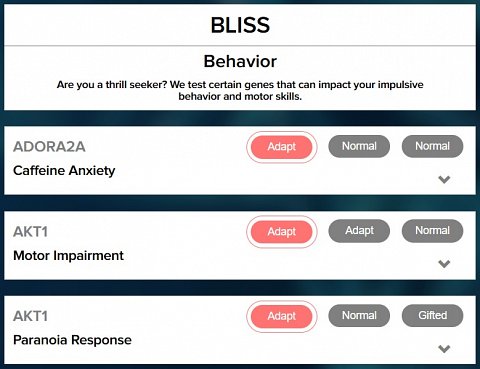
My ‘Adapt’ results for the Behavior results section.
Caffeine anxiety, Motor Impairment, and Paranoia Response all came back as ‘Adapt’. It was useful to know that I was genetically likely to keep caffeine in my system for longer, meaning that I'm more susceptible to anxiety and sleeplessness. I've often found that I have trouble sleeping if I drink coffee too late in the day, and this was a good reason to break the habit.
Motor Impairment and Paranoia Response both turned out to be results in relation to cannabis usage. They showed that I was more likely to have slower reflexes if I used marijuana, and furthermore I was part of the 10% minority who were more likely to develop temporary psychosis as a side-effect. Luckily, my other results had already indicated that I was unlikely to become addicted to marijuana, but this was certainly another deterrent. I found these results interesting, but was a little surprised to see so many of the traits in these tests were specific to drug responses for illegal drugs.
A little further down, I saw a result saying I was ‘Gifted’ for 'Risk Behavior'. This meant I was more likely to act impulsively, to be an extrovert and to seek out novel and thrilling experiences, as these triggered the response of a chemical called dopamine. Some of these traits resonated with me, and although I've never considered myself an extrovert, I certainly enjoy finding new and exciting experiences.
My Risk Behavior result made me wonder how it was decided which of the results were good and which were bad, especially for something this subjective, as there are a lot of situations where risk behavior turns out to be less of a gift. At times it was unclear whether my result was good or bad, for example I didn’t think that being genetically predisposed to being 'Compulsive' was necessarily a good thing, yet the ‘Gifted’ result implied higher levels of compulsion.
Results Section: Tolerance
The Tolerance section looked at my likely responses to stress and pain. I decided to look at some of these results in the downloadable PDF report. This didn’t use the ‘Adapt’, ‘Normal’ and ‘Gifted’ system of reporting the results, instead just using the letters that had labelled the different tabs in the online version (shown below).
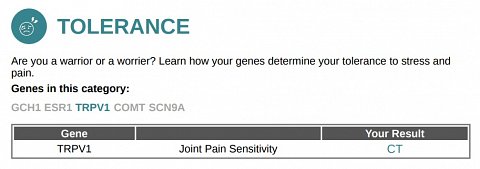
My Joint Pain Sensitivity result in the PDF version .
As with the online results, the percentage of the population that shared this result was included; apparently 35% were like me and had an average amount of joint pain from structural damage. It was explained that the gene was associated with the sensor in the body which is activated by pain from noxious heat and inflammation stimulation. I had never considered that different kinds of pain had different sensors and found it interesting that people experience the different kinds of pain with more or less intensity depending on their genetic makeup.
My result for a trait called 'Warrior or Worrier' came back as mixed, meaning that my pain threshold is intermediate and that I'm less vulnerable to stress. This seemed to contradict my Empathy result from the Behavior section, but I remembered the explanation from earlier and guessed this meant that overall I would likely have an average response to stress. Despite the complexity of my results, I still thought that the DNA test was an interesting lens through which I could view aspects of my personality.
Summary
Overall, ORIG3N's BLISS test provided an interesting insight into my personality. While the results weren't extensive, and some were oddly specific to responses to illegal drugs, I still found that in general the test was an enlightening experience.
I was made conscious of vices I should be more aware of, and of my own genetic strengths, which gave me a new perspective on aspects of my character and behavior. Due to the wide range of traits reported on and the fact that there were some unusual results included, I’d recommend this even to those that have already taken a behavioral DNA test, as well as those that haven’t.
Please note that this test may have changed since our review was written. To ensure you know what to expect from this test, please check the company's website.


